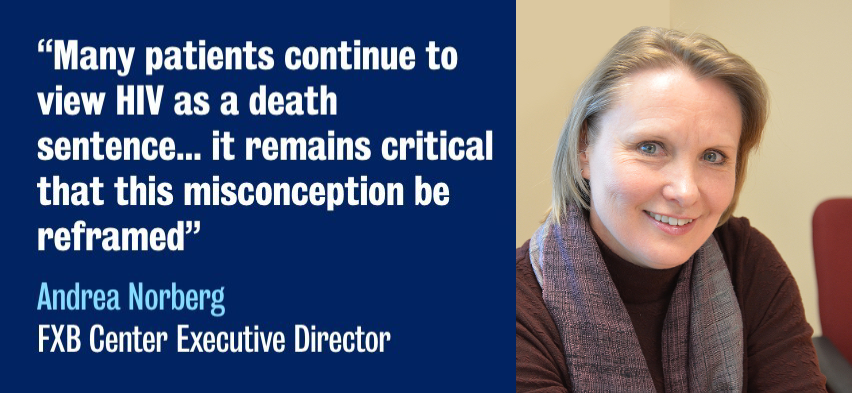
Featured JBISRIR Systematic Review: Experience of HIV-infected adults
JBI interviews JBISRIR Systematic Review author Andrea Norberg, FXB Center Executive Director
A new JBISRIR Systematic Review examines the experience of HIV-infected adults and healthcare providers with healthcare delivery practices that influence engagement in US primary healthcare settings. JBI interviews Andrea Norbeg, Executive Director of the François-Xavier Bagnoud Center and lead author of the JBISRIR systematic review as a part of JBI's featured author series.
Tell us about your JBISRIR systematic review
This qualitative review aimed to examine the experience and perceived impact of healthcare delivery on healthcare engagement for people living with human immunodeficiency virus (HIV) receiving primary healthcare in the US. Specifically, we wanted to better understand the experiences of HIV-infected adults and their healthcare providers with healthcare structures/practices/processes, that impact self-care and support the patient through the processes of HIV testing, linkage to care, ongoing lifetime engagement in care and subsequent HIV viral load suppression.
Why is this an important public health topic in the United States (and worldwide)?
The World Health Organization (WHO) highlights that HIV has to date claimed the lives of more than 34 million people world-wide with 2 million people becoming newly infected each year. The US Centers for Disease Control and Prevention report that 1.1 million people are living with HIV in the US with approximately 40,000 confirmed new diagnoses in 2017 alone. 14% of those living with HIV are estimated to not know they are infected.
What recommendations for practice did you find to improve the experiences of HIV-infected adults related to healthcare practices, processes, systems?
Several important themes arose from the review and are important to consider within clinical practice.
1. Having a positive and trusting relationship with healthcare providers (physicians, nurses and others) is a foundational building block for patients to enter or continue in care. A humanistic response helped patients to deal with their diagnosis, trouble shoot disease management problems, and achieve acceptance in adherence. Some patients perceived that providers were only concerned with medication adherence and not how HIV impacted their whole-life experience. Many referred to this as grilling about medication adherence which inhibited disclosure and damaged the relationship. Providers who used a low-key approach and let the patient know that they could be honest got more accurate data.
Looking for the patient’s motivation and goals, giving suggestions for how other patients adhere and providing information about taking medications in familiar terms were all found to be effective communication techniques.
2. The healthcare system is complex to many patients. Active support through coaching and mentoring, navigating transitions of care, and providing needed resources to bridge gaps and facilitate communication are necessary. Having an ally that actively guides the patient through transitions, simplifies processes and promotes regular and ongoing communication enhances patient motivation by creating a genuine connection, knowledge acquisition and self-advocacy.
3. Helping patients to understand their illness and ongoing care needs using common language and words so that information can be processed and linked back to what is happening to them is very important from the beginning. It is crucial that it be emphasized that HIV is a treatable chronic illness, as many patients view HIV as a death sentence. Still today there is a need to reframe the misconception that HIV=death.
4. One-stop services that assist people with multiple medical care needs and social needs requiring “wraparound” services are important from the initial stage of getting an HIV test to receiving ongoing care. Welcoming clinics that are open to diverse cultures and assure confidentiality, minimize wait times, ensure continuity and demonstrate a coordinated approach among the full healthcare team are desired. Perceived or real threats to confidentiality discourage patients from seeking or from remaining in care. Posting signage that reinforces the confidentiality policy can be reassuring with this population.

In your personal opinion, what would be the recommendation that should be number one priority to implement and why?
I personally believe that there is a need for the healthcare team to bolster competencies in motivational interviewing through experiential learning, observation and hands-on practice. We need to make this a priority in health professions schools and with professionals in practice. Patients express the need for the healthcare team to be “with them” and to demonstrate respect, unconditional empathy and acceptance. Judgement, directive approaches, and perceived constant “grilling” aren’t effective patient-centered strategies and don’t lead to patients being partners in decision making.
What were the findings that surprised you most?
Many patients continue to view HIV as a death sentence in the US. It remains critical that this misconception be reframed to HIV is a treatable chronic condition.
Is there anything in your systematic review that you would like to highlight?
Category 1: A confirming relationship matters
Finding 8: Feelings of confirmation 47(p.71) (U)
‘‘I think it helps to feel like this person is not paid to take care of you; it is more like a friend taking care of me. They want to see me getting better, they are concerned that my condition may be worsening, and they have that loving touch and hug.’’(patient)
Full Citation:
Further Resources
The AIDS Education and Training Center (AETC) Program is the training arm of the Ryan White HIV/AIDS Program established in 1987 by the US Department of Health and Human Services’ (DHHS) Health Resources and Services Administration (HRSA). To access resources: https://aidsetc.org/